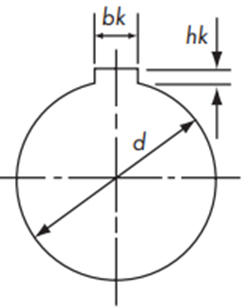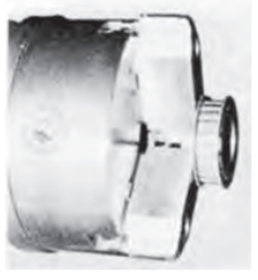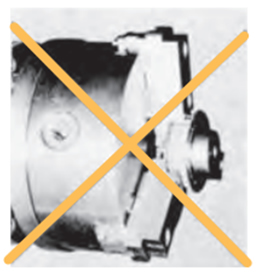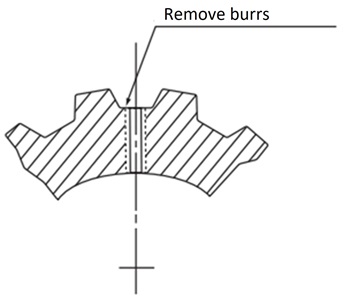Technical Data Synchronous Belts / Belt Sprockets Design Guide
Coupling the belt sprocket and shaft
(1)By use of key
A general method to secure the belt sprocket based on the bore-shaft fitting dimensional tolerances and keyway tolerances.
Refer to the Fit Bores Belt Sprocket, which standardizes the processing of shaft bores, keys, and taps and can be ordered by model number itself.
- ・For the use of aluminum belt sprocket, use under the keyway surface pressure of 80 N/mm2 or lower and for one-way rotation.
- ・To use for forward and reverse rotation, use lock belt sprockets.
(2)By use of frictional force
We offer lock belt sprockets with an integrated friction-type locking device.
For selection of Lock belt sprocket, refer to Lock belt sprocket S Type and Lock belt sprocket C Type.
- ・In the case of friction-type locking devices, such as lock belt sprockets, a strong surface pressure is applied to the main belt sprocket unit. Therefore, high-strength aluminum alloy is used for aluminum belt sprockets. The use of friction type locking devices with additional processing on standard aluminum belt sprockets (products with pilot bore, such as Power- Lock) may damage the belt sprockets and cannot be used.
To use friction type locking devices with aluminum belt sprockets, it is recommended to use our lock belt sprockets.
Shaft hole dimensions and tolerances
Bore and shaft fitting dimensional tolerances (JIS B0401)
| Dimension Range mm | Bore Dimensional Tolerance | Shaft Dimensional Tolerance | ||
|---|---|---|---|---|
| H7 | H8 | h7 | h8 | |
| More than 3, up to 6 | + 12~0 | + 18~0 | 0~-12 | 0~-18 |
| More than 6, up to 10 | + 15~0 | + 22~0 | 0~-15 | 0~-22 |
| More than 10, up to 18 | + 18~0 | + 27~0 | 0~-18 | 0~-27 |
| More than 18, up to 30 | + 21~0 | + 33~0 | 0~-21 | 0~-33 |
| Over 30, up to and incl. 50 | + 25~0 | + 39~0 | 0~-25 | 0~-39 |
| More than 50, up to 80 | + 30~0 | + 46~0 | 0~-30 | 0~-46 |
| More than 80, up to 120 | + 35~0 | + 54~0 | 0~-35 | 0~-54 |
Keyway dimensions and tolerances
For reference, typical dimensions and tolerances for finished Belt Sprocket Fit Bore shaft holes as follows:
New JIS standard key Js9
| Shaft Bore Diameter | Key dimensions | Keyway Depth d + hk |
Keyway Dimensional Tolerance bk |
|---|---|---|---|
| 10以上12 or less | 4×4 | d + 1.8 | 4±0.0150 |
| More than 12, up to 17 | 5×5 | d + 2.3 | 5±0.0150 |
| More than 17, up to 22 | 6×6 | d + 2.8 | 6±0.0150 |
| More than 22, up to 30 | 8×7 | d + 3.3 | 8±0.0180 |
| More than 30, up to 38 | 10×8 | d + 3.3 | 10±0.0180 |
| More than 38, up to 44 | 12×8 | d + 3.3 | 12±0.0215 |
| More than 44, up to 50 | 14×9 | d + 3.8 | 14±0.0215 |
| More than 50, up to 58 | 16×10 | d + 4.3 | 16±0.0215 |
| More than 58, up to 65 | 18×11 | d + 4.4 | 18±0.0215 |
| More than 65, up to 75 | 20×12 | d + 4.9 | 20±0.0260 |
| More than 75, up to 85 | 22×14 | d + 5.4 | 22±0.0260 |
| More than 85, up to 95 | 25×14 | d + 5.4 | 25±0.0260 |
Old JIS key E9
| Shaft Bore Diameter | Key dimensions | Keyway Depth d + hk |
Keyway Dimensional Tolerance bk |
|---|---|---|---|
| 10以上13 or less | 4×4 | d + 1.5 | 4 +0.050 |
| More than 13, up to 20 | 5×5 | d + 2.0 | 5 +0.050 |
| More than 20, up to 30 | 7×7 | d + 3.0 | 7 +0.061 |
| More than 30, up to 40 | 10×8 | d + 3.5 | 10 +0.061 |
| More than 40, up to 50 | 12×8 | d + 3.5 | 12 +0.075 |
| More than 50, up to 60 | 15×10 | d + 5.0 | 15 +0.075 |
| More than 60, up to 70 | 18×12 | d + 6.0 | 18 +0.075 |
| More than 70, up to 80 | 20×13 | d + 6.0 | 20 +0.092 |
| More than 80, up to 95 | 24×16 | d + 8.0 | 24 +0.092 |

When keyway processing is needed, please provided us the dimensions and tolerance.
If no specification is provided, it will be processed according to the tolerances shown in the table above.
Surface treatment
Various surface treatments are available according to applications.
| Type of Surface Treatment | Effect | Applicable Material |
|---|---|---|
| Blackening | Rust prevention, decoration | Carbon steel for machine structural use |
| Electrogalvanization | Rust prevention, decoration | Carbon steel for machine structural use |
| Electroless nickel phosphorus plating | Rust prevention, decoration | Carbon steel for machine structural use |
| Alumite | Rust prevention | Aluminum alloy |
| Hard alumite | Rust prevention, wear resistance | Aluminum alloy |
Additional processing of stock items
The best way to process a shaft bore of a belt sprocket is to secure the outer diameter of the teeth section with a chuck. However, in the case of the BF and B Type Standard Belt Sprockets, the concentricity of the outer diameters of the teeth section and the hub is machined correctly. Therefore, it is recommended to secure the outer diameter of the hub with a chuck when processing shaft bore.
In addition, as the flange rotates when machining a DF Type Belt Sprocket, put a setscrew in the tapped hole before machining to prevent rotation.

An example of chucking BF type

Never chuck flange part.
Hole Tapping
When tapping the bottom, remove burrs completely as they will damage the belt. (For belt sprockets with hub, tap the hub.)


